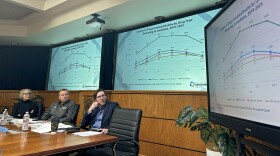Security recommendations for the French Quarter from a consulting firm hired by the New Orleans Police and Justice Foundation sparked tense debate between street performers, business owners, residents and service industry workers at a packed town hall meeting Wednesday.
The presentation at the Omni Royal Orleans Hotel outlined preliminary plans that would close Bourbon Street to vehicular traffic from Iberville Street to St. Anne Street for most of the day. The report, from consulting firm Teneo and commissioned by New Orleans Police Department Chief Anne Kirkpatrick, also includes suggestions for deploying officers, enhancing surveillance technology and installing barriers designed to blend with the French Quarter’s historic aesthetic — like a security gate similar to those used at Buckingham Palace in London.
The meeting was presented by the NOPD and the Vieux Carré Property Owners, Residents, and Associates (VCPORA). Tensions ran high at the meeting, with attendees voicing concerns about the impact of pedestrianization on accessibility, business operations and emergency response times.

While some residents and business owners welcomed the idea of limiting vehicle access to increase public safety, others worried about unintended consequences. First responders, including representatives from the New Orleans Firefighters Association, emphasized the need to maintain rapid access for emergency vehicles. Andrew Monteverde, the association’s vice president, warned that restricting street access could impede firefighters’ ability to navigate the Quarter’s narrow streets during critical moments.
Street performers and musicians, who play a crucial role in the French Quarter’s cultural fabric and identity, also shared their concerns. Elizabeth Vargas, a musician who regularly performs on Royal Street, urged city officials to preserve existing pedestrian areas for artists.
“We are part of what makes the city a place that people want to come to,” Vargas said.
Additionally, some expressed concerns about the impacts on service industry workers, whose input was not sought for inclusion in the report.
“The workforce’s voice is not really represented here,” said Mark Schettler, executive director of Shift Change, a local nonprofit that advocates for people in service, nightlife and hospitality industries. “If they can expend resources to talk to business owners, they can expend resources to hear from residents, that's great.
“But there are a lot of other people in the Quarter who are affected by this, and it's been this way for a long time, that [their] voice isn't considered.”

While no final decisions have been made, officials, including Mayor LaToya Cantrell and members of the New Orleans City Council, are reviewing Teneo’s recommendations ahead of major spring events such as the French Quarter Festival and the New Orleans Jazz & Heritage Festival. These discussions are occurring in the absence of heightened federal security, which had been in place following the New Year’s Day terror attack that killed 14 and injured dozens for large-scale events like the Super Bowl and Mardi Gras.
Eighth District NOPD Captain Sammy Palumbo stressed the importance of a holistic approach, considering not only security but also traffic flow, parking and business needs. He told attendees that any plan implemented would be subject to further community input.
“If they’re here, they have an interest in the French Quarter,” Palumbo said of the meeting’s large turnout. “Just because they don’t live here doesn’t mean they don’t have a good idea that we might need to look at.”
As the city works to balance security with cultural and economic needs, the debate over Bourbon Street’s future remains ongoing. The next steps will depend on how city leaders incorporate feedback in crafting a plan that prioritizes safety without compromising the French Quarter’s unique and historic character.
This story was produced by the Gulf States Newsroom, a collaboration between Mississippi Public Broadcasting, WBHM in Alabama, WWNO and WRKF in Louisiana and NPR.











